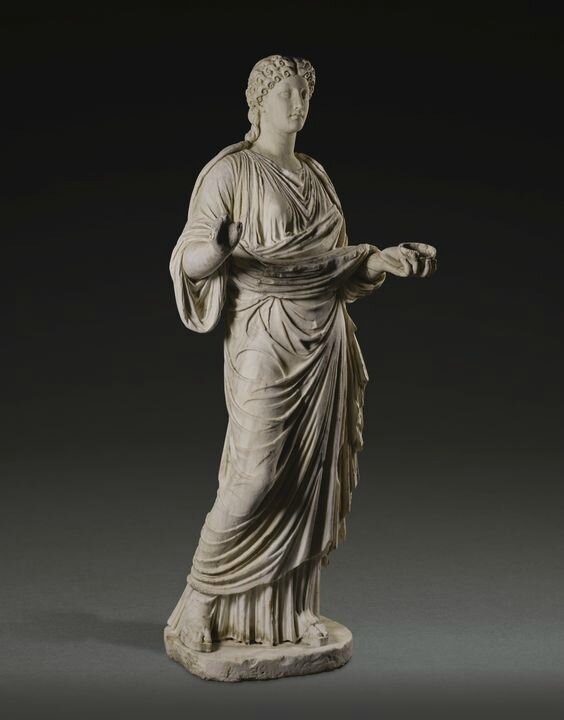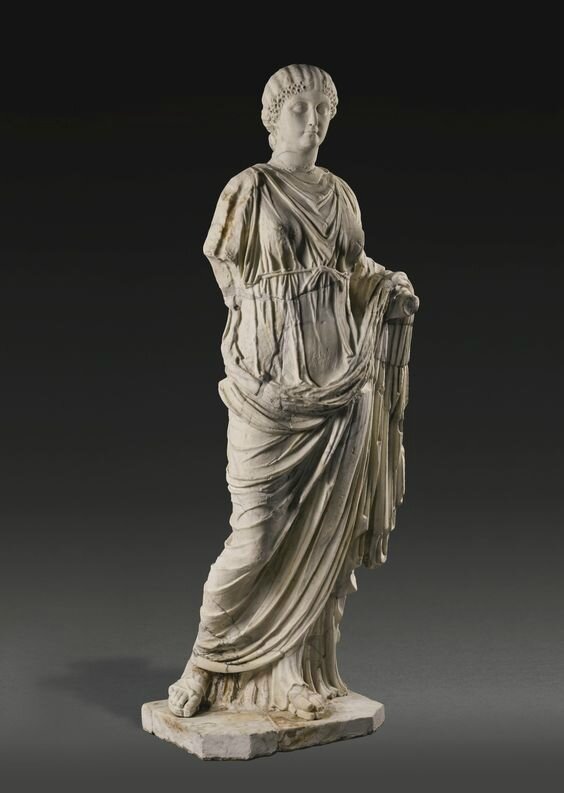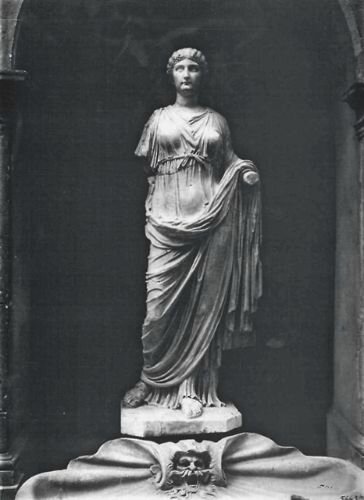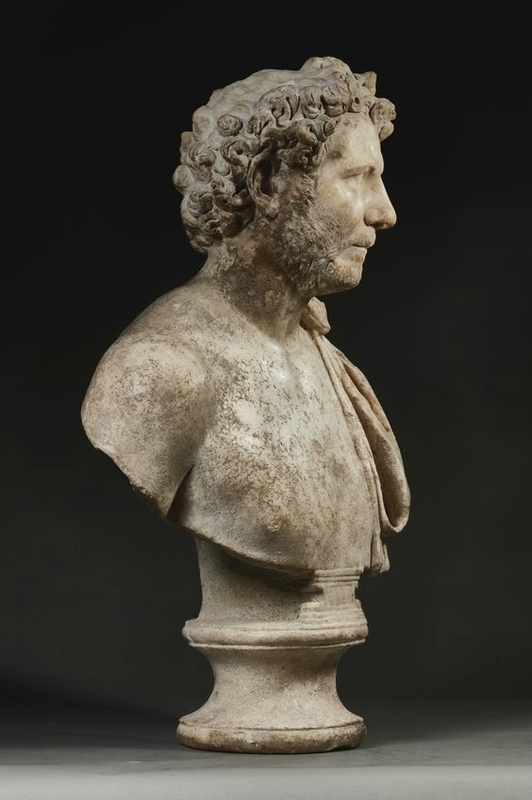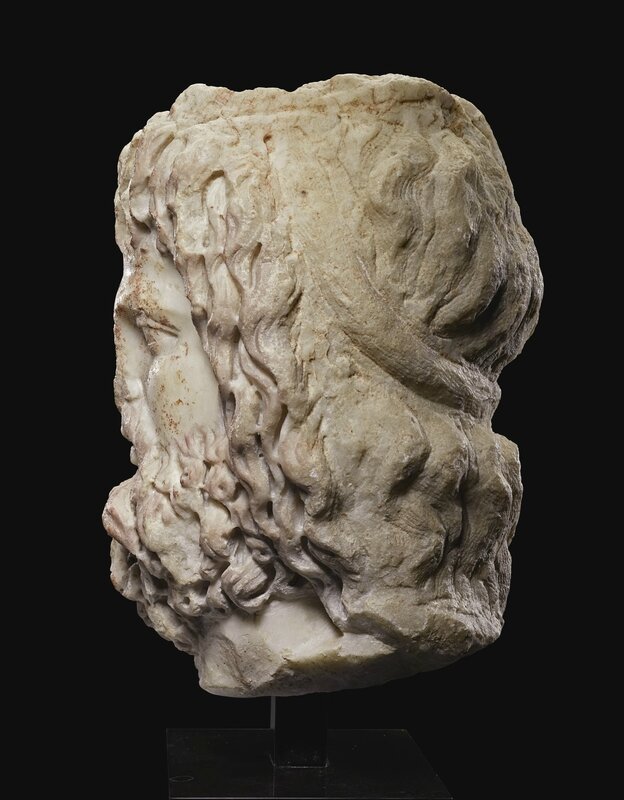![1]()
Four Roman Marble figures of women, circa 2nd Century A.D. (from left to right, est. £250,000-350,000, £150,000-250,000, £100,000-150,000, £150,000-250,000) sold separately. Photo: Sotheby's.
London - An auction dedicated exclusively to the classical world, Ancient Marbles will take place on 12 June at Sotheby’s London – offering ancient sculpture and works of art from the Greek, Roman and Etruscan periods. Since the Renaissance, collecting ancient classical marble sculpture has been considered synonymous with good taste and the apex of culture, and Sotheby’s exhibition will draw on these roots whilst also presenting the pieces in a contemporary context. The auction will be led by a Roman marble bust of a military officer, a striking piece that depicts a single sitter yet represents an entire era – acting as a reminder of the way in which antiquities have influenced artists throughout history, who continue to use portraiture as a representation of their times. Many artists themselves have been avid collectors of classical sculpture, from Rubens through to Cy Twombly. With estimates ranging from £2,000 to £500,000, the sale presents an opportunity for first time buyers as well as seasoned collectors.
Florent Heintz, Sotheby’s Worldwide Head of Ancient Sculpture and Works of Art, said: “The storied pasts of ancient marbles are central to their allure, transporting the viewer back thousands of years and capturing the imaginations of institutions and private collectors alike. This can be felt particularly in the top lot of the sale, the magnificent Roman bust, whose character shines through from the exuberance of his hair to the direct power of his gaze. The interest in the field has been expanding in recent years, with a growth in Medici-style collectors who wish to live with the best of the best – be it an antiquity or a contemporary artwork.”
From Ancient Rome to 1960’s Jamaica: The Story of Four Statues.
In homage to the Villa Adriana in Italy – a vast palace with many pools, baths and fountains constructed as a retreat for Emperor Hadrian – this group of four ancient Roman statues have been set in a stunning colonnade around a swimming pool in the opulent ‘El Cerro’ villa in Jamaica for half a century.
![2]()
The statues shown around the pool at the Coopers' luxurious Montego Bay villa.
In 1968, Douglas and Diene Cooper, jewellers from Philadelphia, inaugurated El Cerro – their magnificent new villa overlooking Montego Bay. Everything at El Cerro reflected the luxurious lifestyle of Philadelphia’s high society, from the octagonal living room echoing the shape of a diamond to the Michelangelo-esque painted frescos and a chess set created by Duchamp for his friend Dali. Indeed, the jet-set photographer Slim Aarons included a view of the statues and pool in his book A Wonderful Time: An Intimate Portrait of the Good Life (1974). The couple even hosted a toga party like no other on the Ides of March in 1974, when guests were “commanded” to don Roman costume and attend the feast of Caesar Douglas and Queen Diene of the House of Coopers. A guest commented to a Philadelphia newspaper, ‘I have been to many fun parties in my life, but never have I been to anything quite like this Roman Bacchanal’.
![3]()
Coverage of the Coopers' 1974 party in the Philadelphia Inquirer.
These ancient statues will now be returning to London, having been acquired from Crowther’s in the 1960s, in what is a rare opportunity to acquire four statues of this scale at the same time.
![3]()
![4]()
![5]()
![6]()
![7]()
Lot 42. Property from the Collection of late Diene and Douglas Cooper, Montego Bay, Jamaica. A Monumental Roman Marble Portrait Statue of a Woman, circa 2nd Century A.D. Estimate 250,000 — 350,000 GBP. Photo: Sotheby's.
standing with the weight on her left leg, and wearing sandals, chiton, stola, and mantle; the head incl. neck, left hand with cup and adjoining drapery, and right arm incl. shoulder restored. Total height 209 cm.; height without plinth 201 cm.
Provenance: private collection, Rome, 18th/19th Century (based on restoration techniques)
photographed in Rome prior to 1924 (Reinach, op. cit.)
Bert Crowther, Syon Lodge, Islington, Middlesex, photographed in 1962
Douglas James Cooper (1931-1988) and Diene Cooper, born Pitcairn, El Cerro, Tamarind Hill, Montego Bay, Jamaica, installed in the house prior to its completion in 1968
acquired with the house by the current owners in 2009 and removed from the premises in 2016.
Literature: Salomon Reinach, Répertoire de la statuaire grecque et romaine, vol. 5, Paris, 1924, p. 375, no. 8 ("Rome. Tête et bras mod. Phot. env. par Helbig“)
The Philadelphia Inquirer, August 4th, 1968, p. 73
"Beauty: A Way of Life," The Morning News, Wilmington, Delaware, March 26th, 1971, p. 35, illus. (reversed)
"Roman Bacchanal in Montego Bay, Jamaica," The Philadelphia Inquirer, Sunday, March 10, 1974, p. 123
Slim Aarons, A WonderfulTime: An Intimate Portrait of the Good Life, New York, 1974 (http://www.gettyimages.co.uk/event/slim-aarons-retrospective-57576281?#the-swimming-pool-at-the-jamaican-home-of-philadelphia-jeweller-picture-id52171077)
https://davidwills.wordpress.com/2011/01/08/barney-bubbles-snaps-maisie-p/ (1962 photograph by Colin Fulcher of Margaret Minay posing next to the statue at Crowther's, Syon Lodge, Islington)
![4]()
Note: The stola suggests a portrait statue. For the draping of the mantle cf. a statue in Sparta: http://arachne.uni-koeln.de/item/objekt/30646. The 18th/19th-century head imitates portraits of Agrippina Minor; cf. B. Andreae, ed., Bildkatalog der Skulpturen des Vatikanischen Museums, vol. I.1, 1994, pl. 174.
Lot 43. Property from the Collection of late Diene and Douglas Cooper, Montego Bay, Jamaica. A Monumental Roman Marble Portrait Statue of a Woman, circa 2nd Century A.D. Estimate 150,000 — 250,000 GBP. Photo: Sotheby's.
standing with the weight on her left leg, and wearing a chiton and mantle wrapped around the upper body; head incl. neck, right hand, front of base and feet restored, left hand formerly restored, area between right and left wrists recarved. Total height 213 cm.; height without plinth 201 cm.
Provenance: European private collection, circa 18th Century (based on restoration techniques)
Douglas James Cooper (1931-1988) and Diene Cooper, born Pitcairn, El Cerro, Tamarind Hill, Montego Bay, Jamaica, installed in the house prior to its completion in 1968
acquired with the house by the current owners in 2009 and removed from the premises in 2016.
Literature: Ruth Seltzer, The Philadelphia Inquirer, August 4th, 1968, p. 73
Scott Straley, "Beauty: A Way of Life," The Morning News, Wilmington, Delaware, March 26th, 1971, p. 35, illus. (reversed)
Slim Aarons, A Wonderful Time: An Intimate Portrait of the Good Life, New York, 1974 (http://www.gettyimages.co.uk/event/slim-aarons-retrospective-57576281?#the-swimming-pool-at-the-jamaican-home-of-philadelphia-jeweller-picture-id52171077)
Note: The present statue belongs to a Hellenistic type known from several other copies (see H.J. Kruse, Römische weibliche Gewandstatuen des 2. Jhs. n. Chr., 1975, p. 455, note 285), to which should be added a statue in Barcelona: P. Vélez, ed., Fons del Museu Frederic Marès. Cataleg d'escultura, 2010, pp. 62ff., no. 4. The missing drapery fold connecting the right and left wrists is the only feature that sets it apart from the type. This feature was either omitted by the ancient sculptor or more likely removed in modern times by the restorer.
![6]()
Another copy of the present type in the Palazzo Doria (photograph by J. Deterling)
![7]()
![8]()
![9]()
Lot 41. Property from the Collection of late Diene and Douglas Cooper, Montego Bay, Jamaica. A Monumental Roman Marble Portrait Statue of a Woman, circa 2nd Century A.D. Estimate 150,000 — 250,000 GBP. Photo: Sotheby's.
standing with the weight on her left leg, wearing a chiton and stola, both high-girdled, and a mantle wrapped around the legs and draped over the left forearm; restored are the head incl. neck, left lower arm with adjoining drapery, feet, lower edge of drapery, and plinth, right arm formerly restored, upper and lower body possibly not belonging together. Total height 194 cm.; height without plinth 185 cm.
Provenance: Italian private collection, 18th Century (based on restoration techniques)
Stefano Bardini (1836-1922), Florence, late 19th/early 20th Century
Douglas James Cooper (1931-1988) and Diene Cooper, born Pitcairn, El Cerro, Tamarind Hill, Montego Bay, Jamaica, installed in the house prior to its completion in 1968
acquired with the house by the current owners in 2009 and removed from the premises in 2016.
![6]()
The present lot in Florence with Stefano Bardini, circa 1900 (Capecchi, op. cit.)
Literature: Gabriella Capecchi, L’archivio storico fotografico di Stefano Bardini. Arte greca, etrusca, romana, Florence, 1993, p. 38, pl. 94
The Philadelphia Inquirer, August 4th, 1968, p. 73
"Beauty: A Way of Life," The Morning News, Wilmington, Delaware, March 26th, 1971, p. 35, illus.
"Roman Bacchanal in Montego Bay, Jamaica," The Philadelphia Inquirer, Sunday, March 10, 1974, p. 123
Slim Aarons, A Wonderful Time: An Intimate Portrait of the Good Life, New York, 1974,
Axel Filges, Standbilder jugendlicher Göttinnen, Cologne, 1997, p. 163, note 643, no. 47
Note: The stola indicates that the present figure was designed for a portrait head; cf. two statues from Spain: P. León, ed., Arte romana de la Bética. Escultura, 2009, p. 258f., figs. 348 and 353. The 18th/19th-century head imitates portraits of the Claudian period; cf. G. Lahusen and E. Formigli, Römische Bildnisse aus Bronze, 2001, p. 134, no. 76.
![8]()
![9]()
![10]()
Lot 44. Property from the Collection of late Diene and Douglas Cooper, Montego Bay, Jamaica. A Roman Marble Figure of Julia Mamaea, the Body circa 2nd Century A.D., the Portrait Head circa A.D. 222–235. Estimate 150,000 — 250,000 GBP. Photo: Sotheby's.
standing with the weight on her left leg, and wearing a chiton and mantle draped across the chest from her left shoulder and falling in long folds over her left arm, the head turned to her right; neck, nose, mouth, parts of diadem and hair, shoulders and upper back, area around both knees, feet, and plinth restored. Total height 190 cm.; height without plinth 180 cm.
Provenance: Italian private collection, circa 18th Century (based on restoration techniques)
Stefano Bardini, Florence, late 19th/early 20th Century
Douglas James Cooper (1931-1988) and Diene Cooper, born Pitcairn, El Cerro, Tamarind Hill, Montego Bay, Jamaica, installed in the house prior to its completion in 1968
acquired with the house by the current owners in 2009 and removed from the premises in 2016.
![6]()
The present lot in Florence with Stefano Bardini circa 1900 (Capecchi, op. cit., pl. 97)
Literature: The Philadelphia Inquirer, August 4th, 1968, p. 73
Gabriella Capecchi, L’archivio storico fotografico di Stefano Bardini. Arte greca, etrusca, romana, Florence, 1993, p. 39, pl. 97f.
Axel Filges, Standbilder jugendlicher Göttinnen, Cologne, 1997, p. 269, no. 129, illus.
Note: Related statues have been compiled and discussed by Filges (op. cit.), pp. 84ff. Julia Mamaea was the mother of and close advisor to emperor Alexander Severus (reigned A.D. 222-235). For the portrait type see K. Fittschen and P. Zanker, Katalog der römischen Porträts in den Capitolinischen Museen, vol. 3, 1983, pp. 30ff., no. 33. Other portraits of Julia Mamaea were sold at Sotheby’s, London, July 10th, 1990, no. 275 (now in a German private coll.: A. Mlasowsky, Imagines imperii, 2006, p. 119f., no. 28, pl. 39f.), and at Sotheby’s, New York, December 7th, 2005, no. 61.
A Roman Imperial Marble Portrait Bust of a Man, 2nd half of the 2nd Century A.D.
The auction will be led by an exceptionally well-preserved and powerful portrait Roman bust of the mid to late 2nd Century A.D., with an estimate of £300,000-500,000. Carved out of a single piece of marble, this depiction of a high ranking military officer is virtually intact and provides a glimpse into Roman personalities through their portraiture. The rarity of the bust lies in the fact that the head belongs to the same piece of marble as the base, along with the condition of the surface, which was not, as was often the case, over-cleaned and retains most of its original polish. Acquired in 1965 by the Denver Museum of Art, it is now being sold to benefit the Museum’s acquisition fund.
The aesthetic achievements of ancient Rome stand as a great milestone in the history of art, and it is in the area of portraiture that Roman sculpture really comes to the fore and differentiates itself from other artistic traditions. This period’s inclination towards realism and accurate descriptions were crucial in the development of realist portraiture. Viewed now as works of art, the Romans would have commissioned such portrait busts as objects of commemoration. For private individuals, these were displayed in the home or in a funerary context whilst for public figures, such as emperors, generals, and statesmen, they would have been erected in public places. Moreover, Romans believed that a person’s individuality was inherent wholly in their facial features. Thus, the artistic realism was often employed to express socially approved values – qualities of selfless duty to the state, sober morality, military bravery and public responsibility. In this case, a determined turn of the head betrays the strong character of the subject. This bust also displays another innovation in the rendering of the eyes, as previously, pupil and iris had only been painted on to the sculpture but now these also came to be sculpted.
It was the convention to imitate the hairstyle of the current emperor, and this portrait finds its closest parallels in those of Antonius Pius – one of political philosopher Machiavelli’s "Five Good Emperors". Distinguished by the cape (paludamentum) worn over his shoulder, it is most likely that he was a member of the elite senatorial or equestrian class – the military reference thus indicating his social class.
![9]()
![10]()
![11]()
![12]()
![13]()
Lot 51. A Marble Portrait Bust of a Man, Roman Imperial, Early Antonine, mid 2nd Century A.D. Estimate 300,000 — 500,000 GBP. Photo: Sotheby's.
his head turned to his left, and wearing a military cloak (paludamentum) fastened with a domed brooch in the form of a rosette, his face with short beard, straight nose, eyes with incised irises and drilled pupils, and furrowed brow, the hair radiating from the crown in exuberantly asymmetrical curls massing above the ears, one curled lock falling over the forehead, the entire bust and its pedestal carved in one piece; tip of nose incl. left nostril restored in marble, tip of beard in painted plaster. Total height 76.5 cm.; height without socle 56.5 cm.
Provenance: Rome art market, 1960 or earlier
Adolph Loewi, Inc., Los Angeles, acquired in Rome prior to 1961
acquired from the above by the Museum in 1965 (inv. no. 1965.22)
Exhibited: "Roman Portraits: A Loan Exhibition of Roman Sculpture and Coins from the First Century B.C. through the Fourth Century A.D.," Worcester Art Museum, Worcester, Mass., April 6th - May 14th, 1961
"I, Claudia. Women in Ancient Rome," Yale University Art Gallery, New Haven, Conn., September 6th-December 1st, 1996, San Antonio Museum of Art, San Antonio, Tex., January 3rd-March 9th, 1997, and North Carolina Museum of Art, Raleigh, N.C., April 6th-June 15th, 1997
Literature: RECORDED
three photographs accessioned in 1960, Deutsches Archäologisches Institut, Rome, neg. nos. 60.2432–34, labeled "Rom, Kunsthandel" (http://arachne.uni-koeln.de/item/marbilderbestand/1059733, http://arachne.uni-koeln.de/item/marbilderbestand/1059734, http://arachne.uni-koeln.de/item/marbilderbestand/1059735)
five photographs by G. Fittschen-Badura (http://arachne.uni-koeln.de/item/objekt/5133)
PUBLISHED
Michael Milkovich, Roman Portraits, exh. cat., Worcester Art Museum, 1961, p. 46f., no. 19, illus.
Ancient Mediterranean Art. The Denver Art Museum Collection, Denver, 1968, p. 52, no. 58, illus.
Cornelius C. Vermeule, Greek and Roman Sculpture in America, Malibu, 1981, p. 340, no. 293, illus.
Klaus Fittschen, "The Bronze Bust of the 'Young Marcus Aurelius' by Antico and Its Antique Model,“ The J. Paul Getty Museum Journal, vol. 18, 1990, p. 123, note 47
Susan B. Matheson, in Diana E. Kleiner and Susan B. Matheson, eds., I, Claudia. Women in Ancient Rome, exh. cat., Yale University Art Gallery, New Haven, 1996, p. 140, no. 72, illus.
Barbara Borg, et al., Die antiken Skulpturen in Castle Howard, Wiesbaden, 2005, p. 87, note 8
Klaus Fittschen, et al., Katalog der römischen Porträts in den Capitolinischen Museen, vol. 2, Berlin, 2010, p. 111, note 1a
Note: According to Susan Matheson (op. cit., p. 140), “This portrait represents a Roman military officer, distinguished by the cape (paludamentum) he wears over his shoulder. He was probably not a professional soldier, however, but rather a member of the elite senatorial or equestrian class whose command during a specific military campaign would provide the opportunity for political advancement or financial gain. The military reference is thus an indicator of the man’s social class. The portrait depicts a man of middle age. At this stage of his life, it is likely that he would be married and have children. Unless his father was still alive, he would be the head of the household, a position of nearly absolute power in theory, but one subject to negotiation, persuasion and compromise in practice. While he was away on military campaign, his wife would assume full command of both the household and the family business.”
Further Highlights
A Roman Marble Head of Sarapis, late 2nd Century A.D. (est. £60,000-80,000)
This object was formerly in the collection of Louis de Clercq, a French industrialist and politician passionate about archaeology and photography in the 19th century who amassed a remarkable collection – the lion’s share of which is housed at the Musée du Louvre.
Sarapis figured among the international deities whose cult was received and disseminated throughout the Roman Empire. A Graeco-Egyptian god, he was endorsed during the 3rd century B.C. on the orders of Ptolemy I of Egypt as a means to unify the Greeks and Egyptians in his realm. He was depicted as Greek in appearance but with Egyptian trappings, signifying both abundance and resurrection. The Roman cults of Serapis gained in popularity when Vespasian experienced events he attributed to his miraculous agency while he was in Alexandria, where he stayed before returning to Rome as emperor in 70 A.D.
![10]()
![11]()
![12]()
Lot 26. A Roman Marble Head of Sarapis, late 2nd Century A.D. Estimate 60,000 — 80,000 GBP. Photo: Sotheby's.
with full beard and moustache, parted lips, and long deeply-drilled hair bound in a diadem, falling in multiple strands over the forehead, and flowing in long wavy locks down to his shoulders, the top of the head prepared for addition of the modius, the back roughly worked, traces of red pigment over the beard and hair; no restorations. Height 33 cm.
Provenance: said to have been found at Antaradus (modern-day Tartus, on the Syrian coast)
Louis De Clercq (1882-1901), Oignies, inv. no. H 168
by descent to his grand-nephew Comte Henri de Boisgelin (1901-1967), rue de Mazarine, Paris
Nicolas Koutoulakis, Paris and Geneva, 1960s
Drouot-Richelieu, Paris, Millon et Associés, Archéologie et Préhistoire, December 13th, 2016, no. 208, illus.
Literature: André de Ridder, Collection De Clercq. Catalogue, vol. 4: Les marbres, les vases peints et les ivoires, Paris, 1906, p. 38f., no. 34
G.J.F. Kater-Sibbes, Preliminary Catalogue of Sarapis Monuments, Leiden, 1973, p. 77, no. 438 (erroneously as "Paris, Louvre")
Wilhelm Hornbostel, Sarapis, Leiden, 1973, p. 100, note 6, and p. 282, note 2
Note: The present head can be securely identified as one of Sarapis based on the mortise and prepared circular surface for a separately-made modius. However, neither the number of locks falling onto the forehead, nor the disposition of the beard locks match any of the known heads of Sarapis (cf. W. Hornbostel, op. cit.). It may be seen as a free rendering of the god's image.
A Fragmentary Roman Marble Figure of Apollo, 1st/2nd Century A.D., with Venetian restorations, 1st half of 16th century (est. £50,000-80,000)
In the 17th century, this statue of Apollo was displayed in the Villa Montalto in Rome, which had been constructed as the grand residence of Pope Sixtus V. The object appears restored in an early 17th century drawing in the Codex Montalto from this time, reinforcing the belief that the upper part of the body was the work of an early 16th-century Venetian sculptor’s workshop – similar to a number of restored statues in the Archaeological Museum in Venice. This is an exceptionally rare finding, as the majority of restoration on Roman Greek sculptures took place in the 18th century.
![11]()
![12]()
![13]()
![14]()
Lot 19. A Fragmentary Roman Marble Figure of Apollo, 1st-2nd Century A.D., with Venetian Restorations, 1st half of the 16th Century. Estimate 50,000-80,000 GBP. Photo: Sotheby's.
seated on his mantle on a rocky outcrop, his right leg forward, his left leg drawn in, a fragmentary kithara on his left thigh; entire upper body, right lower leg incl. part of base, and a drapery fold restored; for the now missing restorations cf. Montalto Album, fol. 70. Total height 69.5 cm.; height of face 8 cm.
Provenance: Italian private collection, 1st half of the 16th Century (based on the restorations)
Cardinal Alessandro Peretti di Montalto (1571-1623), Villa Montalto, Rome
John Bacon Sawrey Morritt (1772?-1843), Rokeby Hall, Yorkshire
thence by descent, Rokeby Hall (Sotheby’s, London, Medieval, Renaissance, and later Works of Art, June 10th, 1969, no. 83)
acquired at the above sale by the present owner
Literature: drawing, Codex Montalto, between 1615-55, fol. 70 (Anna Seidel, Der Codex Montalto, Mainz, 2016, p. 119, fol. 70, illus.)
inventory of the Villa Montalto, between 1623-31 (M. Barberini in E. Debenedetti, ed., Collezionismo e ideologia. Mecenati, artisti e teorici dal classico al neoclassico, 1991, pp. 47 and 48, one of two seated figures of Apollo exhibited facing each other in the same room and described identically: “Una Statua di Appollo nudo a sedere coll’arpa p.mi 3”).
Friedrich Matz, "Antikensammlungen in England,“ Archäologische Zeitung, vol. 31, 1873, p. 26
Adolf Michaelis, Ancient Marbles in Great Britain, Cambridge, 1882, p. 647, no. 10
Note: In the early 17th Century the statue was displayed in the Galleria of the Casino Felice on the grounds of the Villa Montalto in Rome (Seidel, op. cit., p. 228). The dispersal of the Montalto collection began in 1785 under the auspices of Thomas Jenkins (Seidel, op. cit., pp. 21ff.). J.B.S. Morritt of Rokeby Hall probably began collecting ancient sculpture during or shortly after his Grand Tour in 1794-1796.
![6]()
The present lot in the Codex Montalto, 1st half of the 17th Century, showing the statue fully restored (Seidel, op. cit., fol. 70)
Other marbles documented in the Codex Montalto and sold at Sotheby’s are: a figure of Asklepios (Seidel, op. cit., p. 140, fol. 109; Sotheby’s, London, July 22th–23th, 1957, no. 392, and December 10th, 1996, no. 133), a striding figure of a woman (Seidel, op. cit., p. 155f., fol. 139; Sotheby’s, London, June 9th, 193
For the few marbles still at Rokeby Hall see D. Boschung and H. v. Hesberg, Die antiken Skulpturen in Newby Hall, 2007, pp. 134ff. Dispersed marbles from Rokeby Hall include a Silvanus-statuette sold at Sotheby’s, London, July 10th, 1979, no. 348, and two Greek grave stelai now in the Getty Museum (J. Burnett Grossman, Greek Funerary Sculpture. Catalogue of the Collections at the Getty Villa, 2001, pp. 120ff., no. 44, and p. 130f., no. 47).
In the Villa Montalto the present statuette formed a pair with another seated figure of Apollo playing a string instrument (whereabouts unknown; Seidel, op. cit., p. 120, fol. 71). Based solely on the drawings of these two figures in the Codex Montalto, Seidel hypothesises that they were both restored by Ippolito Buzzi (1562-1634), the same Baroque sculptor believed to have restored another pair of seated Apollos in the Ludovisi Collection. The present lot, however, shows restorations that appear to be earlier in style than those executed by Buzzi. The head in particular is closer to those of restored statues in the Archaeological Museum in Venice, the bulk of which is now attributed to several sculptor's workshops operating in the early 16th Century, including Tullio Lombardo and his relatives (see M. de Paoli, "Opera fatta diligentissimamente": restauri di sculture classiche a Venezia tra Quattro e Cinquecento, 2004).
A Roman Marble Portrait Head of Socrates, 1st/2nd Century A.D., on 18th century herm shoulders (est. £80,000-120,000)
Long lost for decades, this portrait of classical Greek philosopher Socrates’ was rediscovered recently and comes to auction with a provenance dating back to the 19th century, having been in the prestigious collections of Sir John Dickson-Poynder and William Randolph Hearst.
![15]()
![16]()
![17]()
![18]()
![19]()
Lot 48. A Roman Marble Portrait Head of Socrates, 1st-2nd Century A.D., on 18th Century Herm Shoulders. Estimate 80,000-120,000 GBP. Photo: Sotheby's.
his oval face with full beard of long unruly locks, moustache, bulbous nose, high cheekbones, heavy-lidded prominent eyes, and furrowed forehead, his sparse hair falling in long strands over the temples and the nape of the neck; herm shoulders and tip of nose restored. Total height 52.5 cm; height of head 32 cm.
Provenance: Sir John Dickson-Poynder, Bart., later 1st Baron Islington (1866-1936)
Spink & Son, London
Joseph Brummer, New York, inv. no. P2045, acquired from the above on February 24th, 1926
(http://libmma.contentdm.oclc.org/cdm/ref/collection/p16028coll9/id/25944)
William Randolph Hearst (1863-1951), acquired from the above on March 1st, 1928
Butterfield & Butterfield, San Francisco
Manou Mobedshahi, San Francisco, acquired at auction from the above in the early 1980s
Michaans auctions, Alameda, California, Inspiring Interiors. Fine Art, Furnishings & 20th Century Design, September 9th, 2016, no. 3023, illus.
Literature: Greek and Roman antiquities from famous private collections & recent excavations on view at Spink & Son's Galleries, London, S.W.1., 1925, no. 4, illus. ("Life-size Marble Bust of a Philosopher, probably Socrates. ?Greek. Alexandrine period. Lord Islington's Collection")
Note: A head almost identical to the present one was last sold at Christie's, New York, December 10th, 2010, no. 149. Both heads bear a certain similarity to the older portrait type of Socrates (type A: G. Richter, The Portraits of the Greeks, vol. 1, 1965, pp. 110ff., figs. 456ff.; I. Scheibler, Münchner Jahrbuch der bildenden Kunst, vol. 40, 1989, pp. 7ff.). They could also be the portrait of an unknown greek philosopher. For the physiognomy also see a head from Athens: Richter (op. cit.), p. 146f., figs. 807ff.
![16]()
Another Head of the same type, sold at Sotheby’s, New York, December 7th, 2001, no. 118, and at Christie’s, New York, December 10th, 2010, no. 149.
![17]()
Brummer Gallery Records, The Metropolitan Museum of Art, object inventory card number P2045 (detail).
Sir John Dickson-Poynder was a distinguished politician and colonial administrator (see note to Sotheby's, London, Old Master Paintings, July 7th, 2005, no. 50).
A Greek Marble Grave Stele, Ionia, circa late 2nd Century B.C. (est. £45,000-65,000)
Boasting exceptional condition, this funerary stele depicts two youths shaking hands, each wearing traditional Greek garments. This was rediscovered in a private home in California, where it had been kept since the 1920s.
![18]()
Lot 11. A Greek Marble Grave Stele, Ionia, circa late 2nd Century B.C. Estimate 45,000-65,000 GBP. Photo: Sotheby's.
of slightly tapering form and surmounted by a pediment crowned with an acroterion, carved in relief within a recessed panel with two youths shaking hands, each wearing a chiton and himation; no restorations. 63.5 by 34 by 10 cm.
Provenance: Brimo de Laroussilhe, Paris
Joseph Brummer, Paris, inv. no. P83, acquired from the above prior to December 31st, 1924, sent to the New York gallery on June 27th, 1921 (http://libmma.contentdm.oclc.org/cdm/ref/collection/p16028coll9/id/22237)
Mina Merrill Prindle (1864-1963), 2211 Greysolon Road, Duluth, Minnesota, and 1131 Hillcrest Avenue, Pasadena, California, acquired from the above on June 4th, 1930 (a previous sale dated December 17th, 1929 was cancelled for tax reasons)
thence by descent to the present owners
Note: For a closely related example cf. the stele of Antiochis from the Samos Archaeological Museum in Vathy, inv. no. 256: R. Horn, Hellenistische Bildwerke auf Samos (Samos 12), 1972, p. 153 f., no. 132, pl. 73. 96 (E. Pfuhl and H. Möbius, Die ostgriechischen Grabreliefs, vol. 1, 1977, p. 192f., no. 708, pl. 106; http://arachne.uni-koeln.de/item/objekt/216997). The funerary inscription and certain details, such as the palmette within the acroterion, were probably originally painted.
Mina Merrill Prindle appears to have had a particular fondness for ancient objects carved from warm and luminous stones, as evidenced by her Egyptian alabaster vases (and a headrest) sold at Sotheby's, New York, December 2016, nos. 1-8.
For an archival photograph showing the present stele in the Brummer Gallery at 43 East 57th Street, New York, sometime between 1924 and 1930, see http://libmma.contentdm.oclc.org/cdm/ref/collection/p16028coll9/id/56132.























































